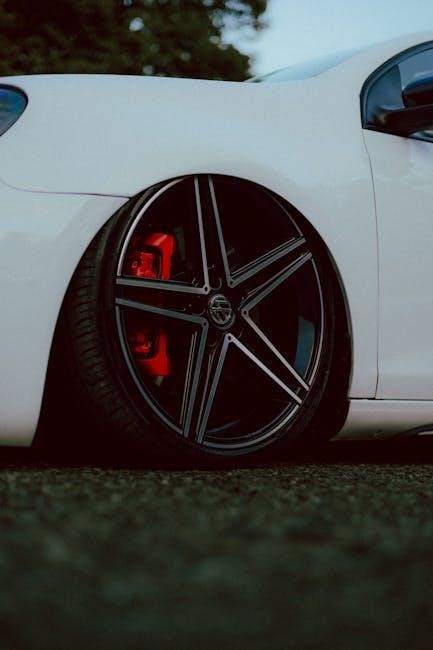Aftermarket wheels are non-OEM wheels designed to enhance vehicle performance, aesthetics, and provide customization options. They offer various styles, materials, and sizes, catering to different preferences and budgets.
1.1 What Are Aftermarket Wheels?
Aftermarket wheels are non-OEM wheels manufactured by third-party companies, designed to replace stock wheels. They are crafted from materials like alloy or steel, offering unique styles, improved performance, and enhanced aesthetics. Unlike factory wheels, aftermarket options provide customization, enabling drivers to personalize their vehicle’s appearance and functionality to suit their preferences and driving needs effectively.
1.2 Why Choose Aftermarket Wheels?
Aftermarket wheels are chosen for their ability to enhance vehicle aesthetics, improve performance, and offer customization. They provide a cost-effective alternative to OEM wheels while allowing drivers to tailor their car’s look and functionality. With diverse designs and materials, aftermarket wheels cater to individual preferences, making them a popular choice for car enthusiasts seeking personalization and value without compromising quality or durability.

Benefits of Upgrading to Aftermarket Wheels
Upgrading to aftermarket wheels enhances performance, boosts aesthetics, and offers customization options while often being cost-effective, making them a popular choice for car enthusiasts seeking improved functionality and style.
2.1 Enhanced Performance
Aftermarket wheels can significantly improve a vehicle’s performance by reducing weight and enhancing aerodynamics. Lightweight materials like aluminum alloys minimize unsprung mass, improving acceleration and handling. Better heat dissipation from advanced designs improves brake performance, while optimized construction reduces vibration, ensuring a smoother ride. These upgrades collectively enhance overall driving dynamics and responsiveness, making aftermarket wheels a practical choice for performance enthusiasts.
2.2 Improved Aesthetics
Aftermarket wheels offer a wide range of stylish designs, finishes, and colors, enhancing a vehicle’s visual appeal. They come in sporty, luxury, or custom looks, allowing owners to personalize their car’s appearance. Upgrading to aftermarket wheels can transform a vehicle’s aesthetic, making it stand out on the road. The right set can elevate a car’s style and reflect the owner’s personality, adding pride and satisfaction to ownership.
2.3 Customization Options
Aftermarket wheels provide extensive customization options, allowing drivers to tailor their vehicle’s look and performance. With various materials like alloy or forged wheels, finishes such as chrome or matte, and a range of colors, drivers can match their wheels to their car’s personality. Custom bolt patterns and offsets further enhance fitment and style, offering a personalized touch that reflects individual preferences and elevates the vehicle’s overall appeal.
2.4 Cost-Effectiveness
Aftermarket wheels offer a cost-effective solution for drivers seeking to upgrade their vehicle without overspending. While initial costs may seem higher, their durability and resistance to wear often lead to long-term savings. Additionally, high-quality aftermarket wheels can enhance resale value, making them a financially savvy choice for those looking to balance performance and budget effectively over time.
Types of Aftermarket Wheels
Aftermarket wheels come in various types, including alloy, forged, and steel options, each offering distinct benefits in terms of strength, weight, and aesthetic appeal for different vehicles.
3.1 Alloy Wheels
Alloy wheels are a popular choice for aftermarket upgrades, offering a blend of style, durability, and performance. Made from a mixture of metals like aluminum and magnesium, they are lighter than steel wheels, improving fuel efficiency and handling. Their sleek designs enhance vehicle aesthetics, making them a favorite among car enthusiasts seeking both functionality and visual appeal.
3.2 Forged Wheels
Forged wheels are premium aftermarket options, crafted using extreme pressure to shape metal into strong, lightweight designs. They boast superior strength-to-weight ratios compared to cast wheels, enhancing vehicle performance and durability. Often favored by high-performance enthusiasts, forged wheels offer unmatched customization, with intricate designs and finishes that elevate both style and functionality for discerning drivers seeking top-tier quality.
3.3 Steel Wheels
Steel wheels are durable and cost-effective aftermarket options, offering exceptional strength and resistance to corrosion. They are often chosen for their affordability and reliability, making them ideal for everyday use. While heavier than alloy wheels, steel wheels provide excellent load capacity and are a practical choice for drivers prioritizing functionality and resilience over aesthetic appeal or performance enhancements.
Understanding Wheel Sizing and Fitment
Wheel sizing and fitment ensure proper installation and performance. Factors like diameter, width, bolt pattern, and offset must align with your vehicle for optimal functionality and aesthetics.
4.1 Wheel Diameter and Width
Wheel diameter and width are critical for proper fitment and performance. Diameter affects handling and tire profile, while width impacts traction and stance. Measure carefully to ensure compatibility, as incorrect sizing can compromise safety and aesthetics. Always refer to your vehicle’s specifications to select the right size for optimal functionality and visual appeal.
4.2 Bolt Pattern and Offset
Bolt pattern and offset are essential for proper wheel fitment. The bolt pattern must match your vehicle’s hub to ensure secure installation, while the offset determines how the wheel sits within the wheel well. Incorrect bolt pattern or offset can lead to improper fitment, vibrations, or damage. Always verify these measurements against your vehicle’s specifications for safety and performance.
4.3 Tire Size Compatibility
Tire size compatibility is crucial for ensuring proper fitment and performance. Always match the tire’s dimensions, load rating, and speed rating to your vehicle’s specifications. Incorrect sizing can lead to poor handling, uneven wear, or even safety hazards. Consult your owner’s manual or a professional to verify compatibility before installing new tires on your aftermarket wheels.

Materials and Construction
Aftermarket wheels are crafted from durable materials like aluminum, steel, and forged alloys, ensuring strength, lightweight design, and enhanced performance. Construction methods vary, impacting both aesthetics and durability.
5.1 Cast vs. Forged Wheels
Cast wheels are manufactured using a casting process, offering a cost-effective solution with diverse design options. Forged wheels, crafted through a forging process, provide superior strength, durability, and lightweight performance. Cast wheels are ideal for everyday use, while forged wheels are preferred for high-performance applications due to their enhanced structural integrity and resistance to stress. Both materials cater to different driving needs and preferences.
5.2 Aluminum vs. Steel Wheels
Aluminum wheels are lightweight, corrosion-resistant, and offer improved heat dissipation, enhancing braking performance. Steel wheels are durable, cost-effective, and ideal for heavy-duty applications. Aluminum wheels are popular for their aesthetic appeal and performance benefits, while steel wheels provide strength and reliability, making them suitable for different driving conditions and vehicle types. Each material has distinct advantages and use cases.

Popular Brands in the Aftermarket Wheel Industry
Leading brands like Enkei, BBS, RAYS, and Vossen dominate the aftermarket wheel market, offering high-quality, stylish, and durable options for various vehicle types and preferences.
6.1 Well-Known Brands
Brands like Enkei, BBS, and RAYS are renowned for their high-performance wheels, blending durability and style. They offer lightweight designs, superior craftsmanship, and a wide range of finishes, catering to enthusiasts seeking both performance and aesthetics. These brands are trusted for their innovative engineering and commitment to quality, making them top choices in the aftermarket wheel industry.
6.2 Emerging Brands
Newer brands like Vossen and Rotiform are making waves with innovative designs and affordable pricing. They focus on modern aesthetics, offering unique finishes and bespoke options. These brands cater to younger enthusiasts and modifiers, providing fresh styles that stand out while maintaining quality and performance standards in the aftermarket wheel market.

Style and Design Considerations
Aftermarket wheels offer diverse design options, from sporty to luxury styles, allowing drivers to personalize their vehicle’s appearance. Custom finishes and unique aesthetics enhance visual appeal, making wheels a key element in car customization.
7.1 Sporty vs. Luxury Designs
Sporty designs emphasize bold, aggressive aesthetics with sharp lines and angular spokes, appealing to performance enthusiasts. Luxury designs focus on elegance and sophistication, often featuring intricate details and premium finishes. Both styles enhance vehicle appeal, catering to diverse preferences and lifestyles, allowing drivers to express their personality through wheel choice.
7.2 Color and Finish Options
Aftermarket wheels offer a wide range of colors and finishes, from sleek black and silver to vibrant chrome. Finishes like gloss, matte, or hyperchrome add visual appeal. Custom colors and specialized coatings, such as anthracite or bronze, provide unique styling options. These choices allow drivers to personalize their vehicle’s appearance, ensuring a seamless match with their car’s overall aesthetic and personal taste.
Installation and Maintenance Tips
Proper installation involves tightening lug nuts to torque specifications and ensuring wheels are balanced. Regular cleaning and inspections for damage ensure longevity and safety on the road.
8.1 Proper Installation Techniques
Always follow manufacturer guidelines for installing aftermarket wheels. Tighten lug nuts in a star pattern to the recommended torque specification. Ensure wheels are properly seated and balanced for optimal performance; Double-check bolt pattern and offset compatibility before installation. Hand-tighten lug nuts initially, then use a torque wrench. Consider professional installation for accuracy and safety;
8.2 Maintenance and Care
Regularly clean wheels to prevent brake dust buildup, using mild soap and water. Inspect for damage like cracks or bends. Tighten lug nuts periodically to ensure safety. Store wheels in a dry, cool place when not in use. Avoid harsh chemicals or abrasive materials that could damage finishes. Proper care extends the lifespan and maintains the appearance of aftermarket wheels.
Buying Guide: What to Look For
When purchasing aftermarket wheels, prioritize quality, durability, and compatibility. Look for reputable brands, warranties, and customer support to ensure a reliable and satisfying purchase experience.
9.1 Quality and Durability
Ensure wheels are made from high-quality materials like forged or cast aluminum for strength and longevity. Look for rigorous testing certifications and warranties, as these indicate reliability and durability. Durable finishes and robust construction ensure wheels withstand various road conditions, providing long-term performance and satisfaction.
9.2 Warranty and Customer Support
When purchasing aftermarket wheels, ensure the manufacturer offers a comprehensive warranty covering defects and durability. A reliable brand provides clear terms, often spanning multiple years, giving you peace of mind. Additionally, look for excellent customer support, including responsive service, knowledgeable representatives, and hassle-free return policies. These factors ensure a smooth ownership experience and protect your investment.
Common Mistakes to Avoid
Common mistakes include incorrect sizing, overlooking compatibility, and ignoring load ratings. Always ensure wheels match your vehicle’s specifications to avoid performance issues and safety risks.
10.1 Incorrect Sizing
Incorrect sizing is a common mistake that can lead to poor handling, reduced performance, and even safety hazards. Ensure wheels match your vehicle’s specifications, including diameter, width, and bolt pattern. Using the wrong size can cause improper fitment, tire rubbing, and alignment issues. Always consult a size chart or seek professional advice to avoid these costly errors.
10.2 Overlooking Compatibility
Overlooking compatibility is a critical error when selecting aftermarket wheels. Ensure the wheels match your vehicle’s make, model, and year, including bolt pattern, offset, and hub size. Ignoring these factors can lead to improper fitment, causing vibrations, poor handling, and potential damage. Always consult a fitment guide or a professional to confirm compatibility before purchasing and installing new wheels.
Aftermarket wheels offer a blend of style, performance, and customization, transforming your vehicle’s appearance and handling. Prioritize compatibility, quality, and professional installation to ensure safety and longevity. By avoiding common mistakes and investing in reputable brands, you can enhance your driving experience while maintaining your vehicle’s integrity. This guide provides a comprehensive roadmap for making informed decisions when upgrading to aftermarket wheels.




About the author